
Isn’t most content online an advertorial these days? With so much conversion architecture built into websites, aren’t we always trying to convert visitors into subscribers, or get them to click on an ad? A proper advertorial definition might include synonyms like native ads, sponsored content, or even infomercial if you’re in broadcasting circles. An advertorial is an ad that walks, talks and acts like an editorial.
When written in-house for products you produce yourself, an advertorial gives enough content away to be useful while teasing more content available in the paid product.
When written by a sponsor, the best advertorials are produced in partnership with the publisher, rather than for them, allowing the publisher to use their editorial chops to deliver quality content on behalf of their sponsors.
Because sponsored content takes the same qualities as original publisher content, everybody wins. The reader is happy because they’re benefitting from the copy, the sponsor wins because the reader has gained a positive perception of the brand, and the publisher is happy because their readers and sponsors are!
[text_ad]
Publisher-Driven Advertorial Definition
Advertorials are traditionally sponsor-driven, so the majority of this conversation below will be about how to work with sponsors to develop advertorials. But increasingly we are seeing and recommending that publishers write advertorials for their own products.
The most significantly successful form of a publisher-produced advertorial is the Library or Content Preview. This is where you develop a soft-sell email marketing campaign that excerpts or samples the content within your archive library and premium collections, with a big push to subscribe for an all-access membership to that content and more related content.
These Previews generally follow a similar formula, and in our experience, it has proven to be a winning one.
The Preview format typically relies on three main sections:
Section 1 is derivative of one or more premium articles. We typically start with an introduction followed by a 300 to 500 word summary from a piece of paid content that tells a part of the story but leaves the audience wanting more. Then we choose three or four related articles and offer 100-word summaries of each, which makes the reader want to click and read the full articles. Each “preview” has a call to action below the excerpt to get the user to click to the full article (if using a metered paywall), or to subscribe to get access to the full library of content.
Section 2 describes the scope of library coverage across what could be dozens or hundreds of articles on that topic. This is where you can talk more about the related articles. For example, if the topic of your Library Preview was about Baking Apple Pies, you could talk about, and link to, premium content on picking the best apples for apple pie, or the best kitchen tools for making apple pie, or a recipe for making the best apple pie crust. These would all be derivative of the featured articles, which would most likely be different apple pie recipes.
Section 3 is a standardized marketing pitch for the entire service that can be recycled from preview to preview. It should be thought of as a control and any changes to it should be tested.
Some publishers we work with choose to make all links point to the subscription page, while others, usually with a metered paywall, link to individual articles in an attempt to use those credits up so that the user is reminded over and over how much they read the content and decide to subscribe on their own, that the subscription is worth their investment. It’s an important test for any publisher sending Previews.
In addition to these sections, we follow best-practices from our best-performing Previews in mind, which we detail in our article, How to Write a Library Preview That Converts. For the next part of this advertorial definition, let’s talk about sponsor-driven advertorials.
Sponsor-Driven Advertorial Definition
In 1980 when our CEO Don Nicholas worked at Sacramento Magazine, the “special advertising section” was the ultimate advertising definition.
As a young sales rep, his territory for this section was Napa Valley (sounds terrible, doesn’t it?). He learned quickly that he could put together 16-20 page “special advertising sections” and get companies to create the content for him. He had wineries, hotels and restaurants on one side supplying him with copy, and on the other side he had an editor-in-chief telling him what he couldn’t do.
The standards for advertorials are what they’ve always been: Make the sponsors who pay happy to be there, make the editors happy to publish it, and make the subscribers happy to read it.
If you’re a publisher who’s been around for a while, particularly a regional publisher, whatever the advertorial definition you’re familiar with, advertorials are an age-old thing, nothing new: well-written and interesting articles that subtly promote the sponsor’s product, or include an ad for it within the copy, and clearly labeled as advertising.
A good direct response copywriter can tell you that good copy and a good lede will sell more products; that if you want to sell a product, you have to give them what they want: more words.
Since we’re no longer limited to a printed magazine page, online articles and email spotlights are the perfect medium for this. At Interweave when we first started selling online advertorial slots well over a decade ago, it was like selling candy to a rich first-grader. We remember John Bolton, one of the Interweave executives, dropping us an email a matter of weeks after we started sending them once a week telling us that they had sold out for 45 weeks, approximately 10 months!
What to Charge for Advertorials
If you’re following the Mequoda Method for multiplatform publishing, advertorials are low-hanging fruit. They’re easy to do and they sell like wildfire. Your biggest concern should be to not undersell them.
For example, a leaderboard ad might be $10 per M, but an email spotlight/advertorial could be in the $30-50 range per M.
In a good example of a case where one of our clients underpriced, they were selling leaderboards for $2 per M to $6 per M on the web, and $30 per M in email. They sold out at lightning speed which told us they may have been a bit underpriced.
As a rule, advertorials should cost three to five times more than your leaderboards. And whatever CPMs you’re getting for a full-page four-color ad, an email advertorial should sell for the same.
Sponsored eBooks – the Eltimate Advertorial Example
Stuart Hochwert runs Prime Publishing. We talk about him often in Mequoda Daily. He’s a member of the Mequoda Digital Publishing Hall of Fame, and this is another good opportunity to bring him up because he’s the king of eBook advertorials, and if there was any advertorial definition on the web worth reading, he’d need to be in it.
Here’s an advertorial example you may not have even thought of yet. Take a look at Mr. Food Easter Celebration: 35 Excellent Easter Recipes Free eCookbook. The cookbook is sponsored entirely by the American Egg Farmers.
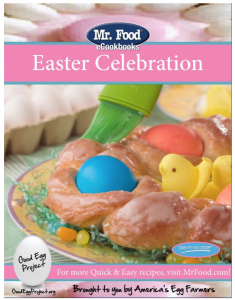 |
Mr Food’s Turnkey Program:
|
It’s made clear that the eBook is sponsored right on the download page, but does this sound like a no-brainer to you, if you’re an advertiser? When the eBook first launched, Amazon and Apple were a huge asset. “We started promoting our eBooks for the Kindle and iPad… and in about 6 months, we had 127,000 eBook downloads via these two stores.”
Hochwert charges anywhere from $20,000 to $50,000 for a full-scale turnkey program like the one you see above. An eBook, like this one for Lion’s Brand Yarn, by itself was around $9,000. That one garnered over 100,000 downloads on their website and another 75,000 via Apple and Amazon in a very short time span after launch.
But wait, there’s more!
A few years ago, Hochwert and team created an eBook titled The Ultimate Craft Guide: 25 Free Craft Projects for Every Crafter that was sponsored by 18 different companies. The main sponsor was Michaels craft store. They got their name on the cover and in other places within the book. Other sponsors got to include different patterns and craft projects with a top-to-bottom banner on the right-hand side of the page. These sponsors paid $2500 – $3000 each, depending on the options they chose.
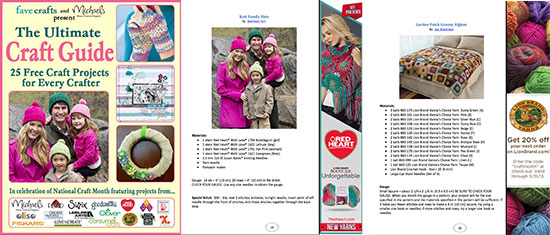
The best part is that readers love them. They’re evergreen, they live forever. Not only are they getting what they ask for (recipes, craft projects, etc.) but they’re getting them from the source, the actual makers of the products they buy, like Lion Brand Yarns and Red Heart.
Advertorials on the Web
Advertorial definitions you read are likely to talk about native ads, because native ads are the same as advertorials in fewer syllables. A sponsor pays you to publish content under their name, or promote them. One of the wackiest advertorial examples out there are those produced by BuzzFeed.
Here’s an advertorial example of a post sponsored by Virgin Mobile on BuzzFeed when they first started their advertorial program many years ago. As a non-publisher, Virgin Mobile worked with BuzzFeed to create almost two hundred of these quick, funny articles that have little to do with their brand but made them buzz-worthy in social media. These posts garnered more than 9 million “engagements,” and studies conducted afterward showed that people who saw these advertorials were anywhere from 150 – 350% more likely to get their next phone from Virgin Mobile.
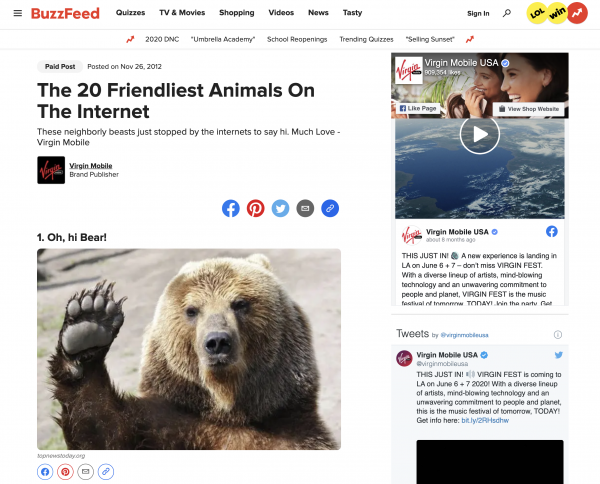
More recently, they’ve used even more advertorial variations, like ad spots throughout their homepage, with videos for their sponsors. This example is for Shaw’s, where they feature how to make a specific recipe. Others we’ve seen are overhead “how-to” recipe videos and we suspect those are produced by BuzzFeed Media Brands’ other property Tasty, which is famous in social for their overhead recipe videos that look suspiciously similar.
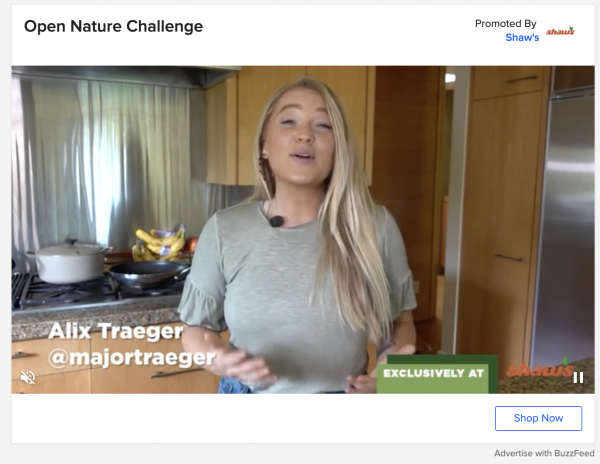
So while some non-publishers are out there trying to write blogs and become online publishers, the smart ones are buying advertorials and letting publishers do what they do best: write! Or in case of BuzzFeed … post funny photos and animated gifs in a list-like order.
One of the ways Hochwert from Prime creates non-eBook advertorials for his advertisers is by writing sponsored product reviews that are affiliated with a contest. Here’s an example of a review for the famous Instant Pot.
“We typically give away at least one item and use one item in our office. Often it’s a craft product or food item, so we use it up. In this case, it’s an appliance, so we will just keep it in office and it will likely be in future videos and photographs,” says Hochwert.
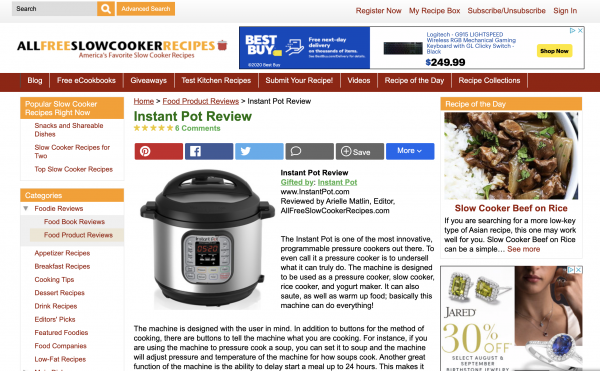
So basically, the client/sponsor gets to promote their product, and Hochwert gets to give something away, which makes his readers happy. Are advertorials sounding better and better by the minute?
For the client who purchases this type of advertorial, they get:
- A product review
- Recipes (or craft projects) using the item
- Full-page solo magazine ads to subscribers promoting the giveaway
- Promotions for the giveaway on their own websites and email newsletters, earned media (bloggers, social media) and paid marketing (i.e. paid search, affiliates).
Readers always know that the promotion is sponsored. Hochwert says that most of his sites do at least one giveaway promotion like this per week. FaveCrafts in particular has a handful live at a time and run for a few weeks.
If you’re not inspired to launch your own advertorial program by the time you’ve reached this point in the article, what’s stopping you? Stuart is one of the smartest publishers we know, and we recommend following him closely!
What more would you like to know about this advertorial definition?
[text_ad]



Per M and CPM = Cost Per Thousand. So, if your magazine reaches 100,000 consumers, and your CPM or Per M is $10 to reach 1000 consumers, the cost to the advertiser is $10 x 100 = $1000. Hope this helps.
What do you mean by “per m”?
Good stuff, Don!